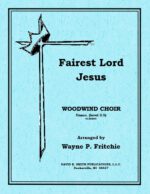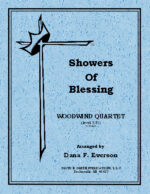-
Dare To Be A Daniel
$3.50This solo with piano begins with the strains of a lion’s roar. Next enters Daniel in a simple fashion followed by a statement in a triumphal march. The lions return-Daniel prevails.
-
Praise Him All Ye Little Children
$3.50This solo with piano begins with a bold march statement with an elongated rhythm of the melody. The middle section is more expressive while the final section imitates the beginning, with a solid statement of faith.
-
Holy, Holy, Holy
$3.50This solo with piano is straight forward in design, giving the young player the opportunity to display dynamic and stylistic variety.
-
-
-
-
Only A Sinner
$10.00A woodwind quartet for Flute, oboe, and two clarinets with optional parts for flute and alto sax. Plus a set of fifth parts for bassoon or bass clarinet can allow for the piece being a quintet. The first statement is in the clarinets where it leads into a full ensemble passing the lines amongst the parts. A delightful little segue leads to a modulation where the tune is in the lower lines alternated with flourishes in the flutes. This Alternating texture carries on for some time. Then the tempo picks up for a vibrant exclamation where the theme is once again bantered about where it makes one final boast and concludes.
-
-
I Will Sing Of The Mercies
$9.00A woodwind quintet with opt. parts for Alto Sax and Bass Clar. This piece presents itself with a sense of joy throughout with the introduction itself in a motivic manner setting the tone The piece passes through several modulations where the upper voices carry the melodic material while the lower voices support the ensemble with strength. The writing of this arrangement is well crafted to take advantage of the “woodwind quintet sounds.” It continues that way right up to the very end with a declamatory statement of “Mercy.”
-
Guide Me, O Thou Great Jehovah
$9.00A woodwind quintet with opt. parts for Alto Sax and Bass Clar. This piece presents itself with a sense of joy throughout with the introduction itself in a motivic manner setting the tone. The melody is fragmented, passing the tune around to the various voices. The middle section mirrors the introduction in texture and again passes melodic material around the different voices. The final section is more subdued until it starts stacking the motifically structured parts until it ascends to a dramatic conclusion.
-
Count Your Blessings
$9.00Be ye thankful! Written for standard woodwind quintet with optional parts, this piece is highly decorated melodically and active rhythmically. It gives both the sense of majesty and joy.
-
Blessed Assurance
$9.00This woodwind quintet (with opt. parts) is constantly on the move. While the melodic material is always made aware, the accompanying parts are full of movement. Even with metrical changes there is a constant flow giving a sense confidence and resolve. It bubbles from beginning to end and finally makes a solid statement of assurance.
-
-
-
I Want Jesus To Walk With Me
$7.00A Woodwind quartet for two flutes and 2 clarinets. A beginning that is yearning in emotion and subtle shifts in harmonic and linear lines. A modulation to a higher tessitura in strong block chords gives a feeling of strength. The piece then settles back into the original key with a series of imitation of the various parts. The piece becomes more solemn as the pitch levels drop until settling into a final cadence.
-
The Master Hath Come
$7.00A Woodwind quartet for two flutes and 2 clarinets. An introduction using unrelated material leads the tune presented in voice two, supported by harmonies in the lower voices, then an obbligato-like motion added by the upper voice. A modulation upward makes room for a duet in the upper lines, later joined by the lower voices in a contrapuntal fashion. The final section becomes more vigorous and imitative until a solid, declamatory ending.
-
Jesus’ Hands Were Kind Hands
$7.00A Woodwind quartet for two flutes and 2 clarinets. The first phrase is stated in the top voice, then adding the second voice, further adding the third voice until all voices are in agreement. The next section moves in a rather jaunty motion going through various meter changes. The middle section is stated with the tune in the top voice with accompaniment figures presented in a syncopated manner. All this happening in a modulated key. Further modulation takes place with a motive stated in the second voice, followed the third, then first until it settles into a final statement of kindness.
-
Jesus, Lover Of My Soul
$7.00A Woodwind quartet for two flutes and 2 clarinets.An opening with an active top voice giving over to the lower voices doing the same. Then in block harmonic movement the pieces moves along with subtle harmonic shifts. The middle section continues in much the same fashion with dynamic shifts. The next area is the same fashion only this time with the lower voices carrying the activity and the upper voice in more solemn movement. The final section is more active with the top voice using material from the introduction and slows to repose.
-
-
-
A Shelter In The Time Of Storm
$9.00An unaccompanied quartet for two flutes and two clarinets. The introduction is presented in a rather rollicking manner where it breaks into a first presentation of the melody- the verse is more said while the chorus is more snappy. A brief transition gives way to the first flute stating the tune, supported by the clarinets with this chorus more block. A modulation takes place using motivic material from the theme with the style smoother and more contrapuntal. The coda section takes from the introduction material and gains dynamic momentum, with a snappy ending.
-
Since I Have Been Redeemed
$9.00An accompanied woodwind quartet for two flutes, two clarinets (and opt. A.Sax). The introduction sets up the emotion of the whole piece which is joy- from beginning to end. The melody is first presented by the flutes and then answered by the clarinets. An interlude is stated by motives leading into a modulation The clarinets once again state the two with joyful punctuations by the flutes. After a brief rit. The piece goes into a slower tempo in four parts where it proceeds to the Coda with motivic statements up to a joyous ending.
-
I Have Come From The Darkness
$9.00An accompanied woodwind quartet score for flute, oboe/flute, clarinet, clarinet/alto sax. A brief introduction in the piano based on a melodic motif. The thematic material is now presented in the full woodwind complement with little snippets added in the piano. The second section is slower and expressive in the solo flute added with a duet line. And interjected by the clarinets on occasion. The ensemble now becomes full and moving together while the legato texture continues in an expressive mood. This solidified format continues as in gravitates ever-upward.

























